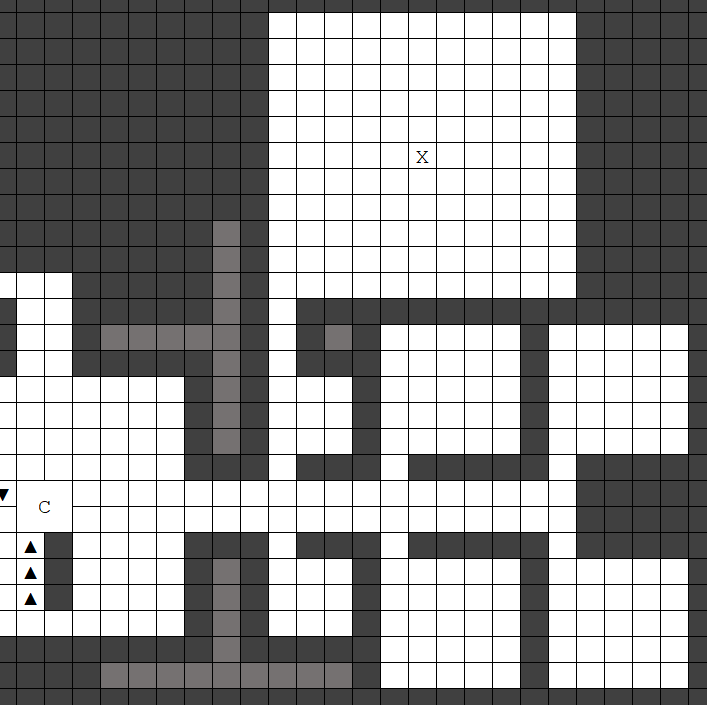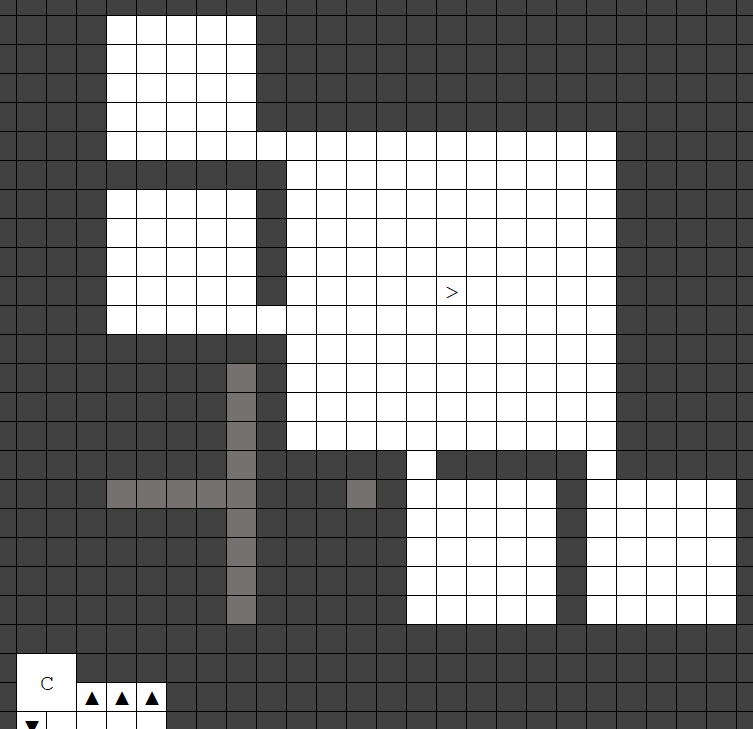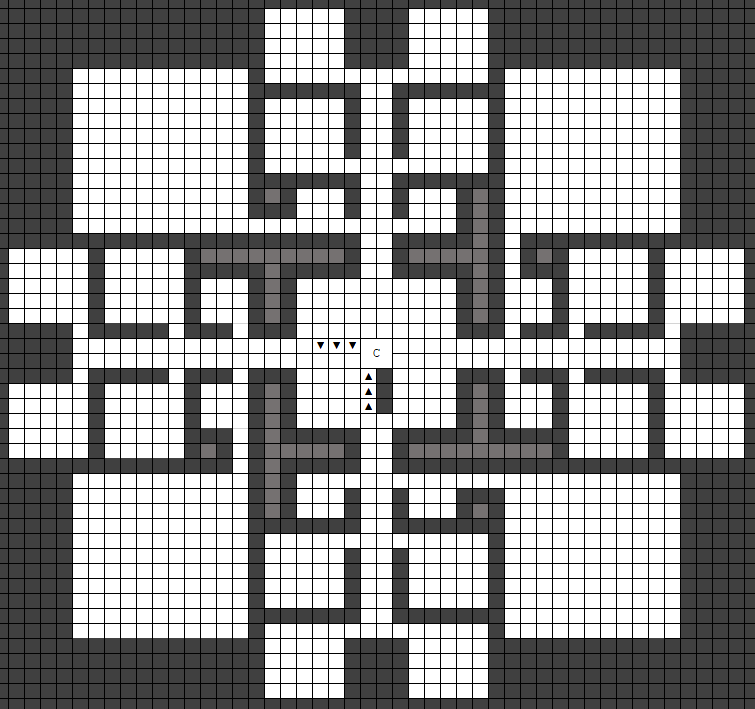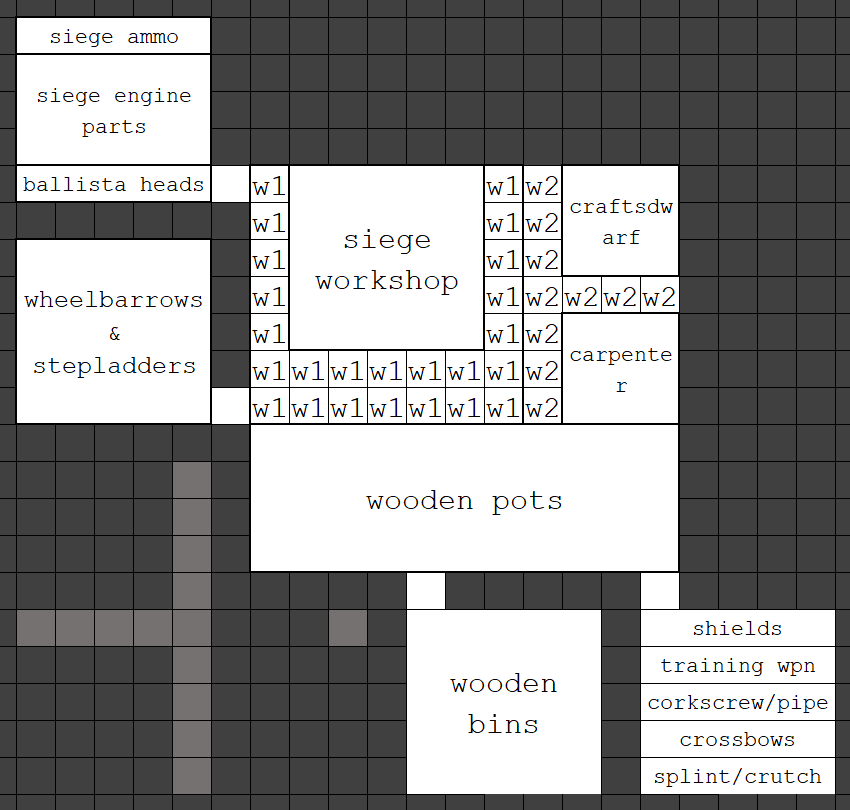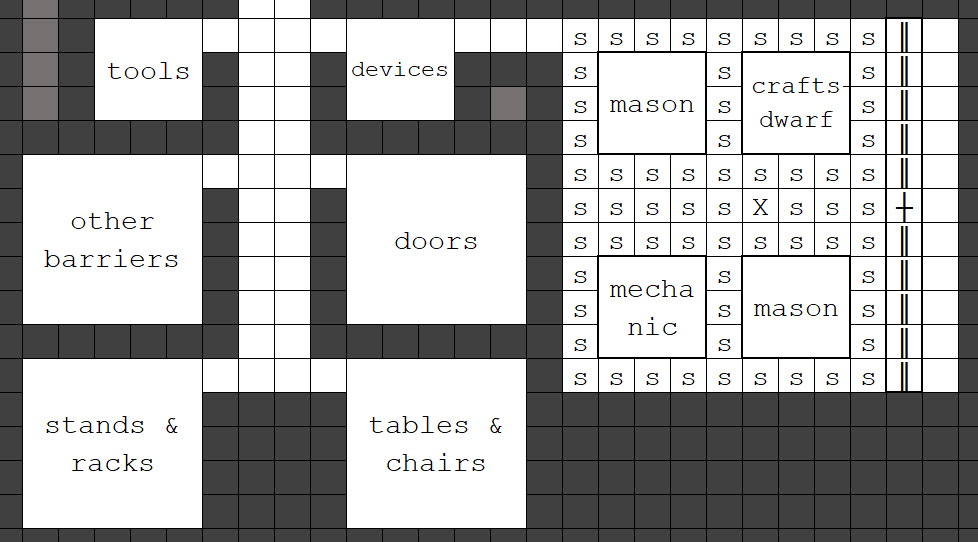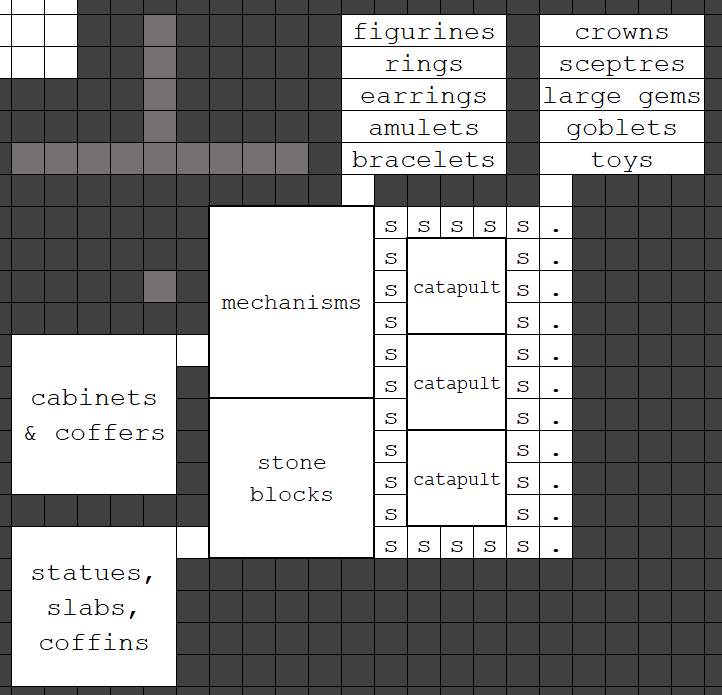- v50 information can now be added to pages in the main namespace. v0.47 information can still be found in the DF2014 namespace. See here for more details on the new versioning policy.
- Use this page to report any issues related to the migration.
User:Mixtrak/Strategy/4 blueprint stone wood
The mad dash is over, and a more thoughtful phase begins. In this section, we are going to make spacious and efficient facilities for the wood and stone industries. In the interests of keeping this page to a reasonable length, we're going to dedicate the entire next section to the (highly complex) food industry.
In order to get these industries bedded in, we must consider the best way to lay out a fortress. Efficient placement of Workshops and Stockpiles is crucial because your wishlist of jobs will usually far exceed your available dwarf-power. Logical and highly-specific compartmentalisation of industry process-chains is also essential to understand and control what is being produced from what, and where things are being stored. You should read about this.
It's likely you'll receive migrants, and possibly a caravan, while finishing this section. You should turn off all the migrant labours except healthcare, hauling and "Other Jobs", but otherwise completely ignore them - we'll recruit them into professions as needed, and eventually the military. However, don't turn off their labours until they're safely inside the fortress - if they're carrying any equipment related to a labour uniform (like a pick, axe, or hunting equipment) and you don't have an appropriate stockpile somewhere, they'll just drop the items where they stand. If this is inside, it's a minor untidyness, but outside, they can get stolen. If you receive a caravan, make note of any gossip if you're interested, but you needn't otherwise trouble yourself about trade priorities or any of the other stuff. We don't have anything ready for trade yet anyway.
Fortress blueprint
Digging a bunch of rooms higgledy-piggledy can cause serious headaches later on, and there are actually a lot of considerations when digging a fortress:
- Did you know that cave-ins will punch through floors if there's a space immediately below? That means that alternating excavated floors with solid rock is fairly sensible. Cave-ins suck. Unstoppable cave-ins suck a lot harder.
- Did you also know that pathfinding is a lot more efficient when there's a small number of paths from A to B? That means that, although highly interconnected patterns might be efficient in terms of minimising detours, they slow your framerate a lot. A branching design with minimal loops and a lot of dead ends might make things a little slower for your dwarves, but they speed the game up considerably for the player. In any case, intelligent placement of infrastructure can help minimise hauling time for your dwarves.
- Do you also know what your layout needs are going to be when you have fifty dwarves? A hundred? Two hundred, and a pile of freeloading booze-guzzlers in your taverns? Neither do I. That means a modular approach is desirable, which can be repeatedly adapted to multiple use-cases as your needs change, and also avoids the work of coming up with a new floorplan for every little section of the fortress.
- Did you also know that, eventually, you will probably have good reasons for piping water, magma, minecarts and power to and from unpredictable locations in your fort? Leaving a lot of space for this kind of plumbing is also sensible.
- And finally, if there's one resource any embark has in abundance, it's depth. A good fortress floorplan makes extensive use of the z-axis.
The wiki contains some advice on Design strategies and they layout of several industries, which we will partially follow. Having considered the points above, and having tried a few zany layouts of my own (did you know hexagons are the most efficient of the self-tesselatory shapes, in terms of space and edge/vertex connectivity?!), I've arrived at the following blueprint. It's pretty efficient, secure, flexible, tileable and shouldn't require extensive remodelling. It might seem complicated at first, but you should have seen the beehive fort. I'll explain the purpose of each feature and once you understand it, it's easier to work with.
The pattern consists of quadrants, each dedicated to a particular industry, arranged around our central ramp which in turn spirals around the xy-origin. The quadrant you've already partially excavated will serve as temporary accommodation for your stone and food industries while we dig the rest.
On level -10, designate the following pattern for your miners (remember to keep your other dwarves busy - but not overloaded - as discussed in the previous section):
As the miners dig, they'll unearth a few interesting gems and bits of ore, but for now, just leave them where they fall.
This serves as the central hub for a particular industry (we'll do the wood industry first), with further rooms above and below. I'd recommend designating the large 11 x 11 room with the up/down stairs (and the tiles required to access it) as priority level 1, so your miners complete this first. As mentioned before, absent detailed instructions miners usually don't complete a room before beginning another due to some quirks of Miner#Mining behaviour, which can be frustrating.
The light grey tiles are not to be mined out yet - they merely show where the plumbing can go in future.
Above and below this level, mine out the following pattern, so that the stairs all line up on the z-axis (yes, it's fine to risk stacking stairs for a few levels):
This shows level -9 (above), but obviously in level -11 (below) you'll designate up-stairs instead of down-stairs.
This design has its advantages
- This mixture of small, medium and large rooms is flexible enough to accommodate farms, workshops, stockpiles, bedrooms, offices, dining halls, barracks, cisterns and just about any other use you can think of, with minimal modification
- The multiple connected rooms enable efficient and organised processing chains
- The blueprint can be tiled vertically - leaving a single unmined layer between units - and (when we eventually run out of z-axis room) horizontally
- The corridors should be sufficiently generous to accommodate foot traffic, and it's a branching, multi-node design which avoids pathing loops and should reduce congestion
- It's easy to install doors (or even bridges) which allow you to lock down/quarantine particular sections
- Thanks to the generous gaps above and below, there's also provision for things like Cleaning#Dwarven Bathtubs - more on these later
It's certainly not the only way to lay out a fort, but if you decide to try something different then at least remember the guiding principles.
When your miners have finished this quadrant, get them digging out another quadrant while you set up the wood industry (see the next section). Eventually, the middle layer (z-level -10) should look like this:
And the levels above and below should look like this, with the only difference being up vs. down stairs:
Yes, things could be packed more tightly, but leaving some space for future needs is prudent. Once your miners have finished these three levels, extend your central ramp down through z-levels -12 to -15 , and start digging another unit of the pattern centred on level -14. Keep tiling the pattern in this order (upper level, middle level, lower level, three gap levels, repeat) until you breach the caverns.
Those constitute another part of this guide, but for now my advice is seal them off and never speak of them again. They are very dangerous! If you get to this stage you can keep your miners busy chasing veins of ores and gems with the special designation options.
Wood industry
It's time to bring the wood industry inside. Wood is vital for all manner of products until it is eventually (mostly) superseded by the metal and glass industries.
Unlike stone, there are not many special kinds of wood you need to worry about at this point in the game. We will, however, reserve the unusually dense bloodthorn and glumprong for ballista arrows. Nether-cap wood has the strange property of maintaining a constant freezing temperature (exactly ten thousand degrees Urist), which obviously can be helpful around magma or for fire-proofing your booze stockpile, but that's not a concern at the moment. In any case, you're unlikely to have access to these woods, since glumprongs only grow in evil areas (and you didn't embark there, right?) an the other two are found in the deep caverns.
You will, however, probably have access to some particularly low-density species through trade: feather tree and candlenut. We'll set up a dedicated stockpile and workshop to reserve these for manufacturing lightweight bins, barrels and wooden pots which will save hauling time.
Middle layer
On the middle layer (z-level -10), lay out the workshops and stockpiles like so:
Be aware that the bowyer's workshop won't actually be completed until you have a dwarf with that labour enabled - this is the case for several other workshops we'll designate. Don't worry about it for now. You can go ahead and remove the carpenter's and craftsdwarf's workshops on the surface.
The w represents a wood stockpile taking from the one on the surface, and giving to each of the four workshops. Your craftsdwarves often use up resources faster than they can be replaced, so a large stockpile of raw materials gives them a larger buffer and reduces job cancellations. As discussed above, you should disable glumprong, bloodthorn, feather tree and candlenut wood from this stockpile. Those go upstairs, which we'll get to next.
For the other stockpiles, make sure they only accept the item in question, and that the only permitted material is wood (the soap stockpile is an exception - this is a bars and blocks stockpile which should only accept soap, not any of the other materials). The "empty cages" stockpile is an animal stockpile from which everything has been disabled except (of course) empty cages. Wheelbarrows fall under "Other large tools" in the furniture stockpile.
You should set them all to "take" from the stockpile in the central rampway, to continue clearing that out.
Upper layer
The layer above looks like this:
Apart from the three workshops (siege, crafstdwarf, and carpenter), here's a list of the stockpiles and their settings (again, unless otherwise specified they should all be set to only accept wood as a material):
- w1: a wood stockpile set to accept only glumprong and bloodthorn, and taking from the surface wood stockpile, and giving to the siege workshop
- w2: as above, set to accept only featherwood and candlenut, and giving to the carpenter's and craftsdwarf's workshops
- Siege engine parts: catapult and ballista parts are a type of furniture
- Siege ammo: a type of furniture. Set it to give to the siege workshop.
- Ballista arrow heads: a type of furniture. This needs to be set to accept metal materials as well. Set it to give to the siege workshop.
- Wooden pots: under furniture, enable only "large pots/food storage". Set this to take from the stockpile in the central rampway.
- Wooden bins: under furniture, enable only "bins". Set this to take from the stockpile in the central rampway.
- Shields: an armour category. Don't bother enabling bucklers or any of the other shield types, just plain shields.
- Training wpn: enable only training axes, training swords and training spears in a weapon stockpile.
- Corkscrew/pipe: Enable only "Enormous Corkscrews" in the "Weapons/Trap Comps" stockpile settings, and "pipe section" under "Furniture/Siege Ammo" stockpile settings.
- Crossbows: enable only "Crossbows" in a "Weapons/Trap Comps" stockpile
- Splint/crutch: enable only these types of goods in a "Finished Goods" stockpile.
Finally, set the normal wood stockpile (downstairs) to give to the siege workshop as well. When you need to make ballista bolts, make sure you choose glumprong or bloodthorn under details, and when you need to make siege engine components, make sure you choose a lighter wood from the downstairs stockpile.
Lower layer
Leave this level empty for now. Later, we're going to use it for manufacturing Soap, Gypsum plaster, Potash, Pearlash, and Quicklime, so it'll be full of kilns and chemicals.
Wood industry priorities
Your wood crafter should focus on churning out wooden pots. You're going to need a lot of those. As for your carpenter, approximate production priorities are as follows (in production runs of 10 for easy tracking):
- 10 beds
- 10 bins
- 10 buckets
- 10 barrels
- A stepladder and 9 wheelbarrows
- 10 cages
- A handful of splints and crutches
As long as you have a reasonable buffer of these items in the stockpiles, your carpenter should probably just focus on felling trees. When your fortress gets large enough, the elves will come and try to impose a quota on your tree-felling; while you can, you may as well get as much lumber on the ground as possible. One hands-off approach is to designate a tree-felling area over the entire map (or, at least, a large area centred on your fort), but set it at priority level 7 (higher numbers are actually lower priority jobs). Whenever your carpenter isn't carpentering or hauling, they'll go and fell trees. You may wish to spare any fruit or nut trees close to the fortress entrance, so your herbalist can have some fruit and nut-gathering zones nearby. Obviously this makes woodcutting one of the most dangerous professions in the fort, so don't forget to frequently monitor the (U)nits menu for threats.
If your carpenter/woodcutter runs out of trees to fell, you may as well fill up those wood-product stockpiles and give them the carpentry experience. Just be cautious of generating a hauling backlog.
Stone industry
We've already discussed most relevant aspects of the stone industry. Most of the products are furniture-like items which need a fair bit of space, so we'll move the temporary workshops and stockpile into another quadrant. In addition, we'll be installing catapults to consolidate all the loose stone that doesn't fit into your stockpile.
Middle layer
Lay out the middle layer like so:
Those double vertical lines (║) represent a wall - preferably made from stone blocks - with a stone door inset. Your mason will be needed to construct this. When the door is in place, forbid it and set it to tightly closed. Stones used as catapult ammunition will fall down there from the level above, and we're blocking it off because you don't want anyone rushing in to pick up stone and getting brained by falling ammo. More on that later.
You're familiar with the stone stockpile settings already. In addition to restricting the types of stone, remember to set number of wheelbarrows to 3, and set it to give to each of the four workshops. You have two mason's workshops because later you'll recruit additional masons and train them by churning out the ever-useful stone blocks.
The other stockpile settings are as follows. For all of them, make sure the material settings only allow the types of stone you're allowing in the stone stockpile.
- "tools": This will hold stone nest boxes, and later bookshelves and hives. The "Tools" category (in the finished goods stockpile) is a bit of a grab-bag of various classes of objects, which can make quite heterogeneous items difficult to keep separate. To achieve this, we'll make different types of tools from other materials.
- "devices" is a furniture stockpile set to only accept querns, millstones, and traction benches.
- "doors" is a furniture stockpile allowing only… can you guess?
- "other barriers" is a furniture stockpile accepting hatch covers, grates, and floodgates.
- "stands & racks" is a furniture stockpile accepting only weapon racks & armour stands.
- "tables & chairs" is a furniture stockpile accepting only… well, you know.
Upper layer
Upstairs is a little more complex:
The catapults are just place-markers for now - you'll recruit a siege engineer later. Set the stone stockpile to accept all types of "Other stone" - yes, all of them - and set number of wheelbarrows to 3 (unfortunately you can't "give" to catapults). The dots along the right-hand wall represent channelled tiles without ramps - just empty space - so the stones fall to the level below. We'll discuss this artillery battery later, but for now suffice to say it's a useful method of consolidating stone and cross-training your dwarves.
The other stockpiles should, again, be set to only allow the types of stone in your main stone stockpile downstairs. Here are the additional settings:
- "cabinets & coffers": a furniture stockpile set to accept only "cabinets" and "boxes and bags"
- "statues, slabs, coffins": a furniture stockpile with these items enabled
- "mechanisms": furniture, only allow mechanisms
- "stone blocks": a bars and blocks stockpile which only accepts stone blocks of the stone types specified in your main stone stockpile.
The two medium-sized rooms along the top each contain five "finished goods" stockpiles allowing only the specified type of item. Toys and goblets have (obvious) uses in your fortress (though stone goblets are called "mugs" when being ordered at the workshop), but the other eight categories can either be specifically ordered or are produced at random from a "make rock crafts" job. These are primarily used as trade goods which use up your most abundant resource: stone.
You'll notice there's no place to put large rock pots, because I'm assuming you have plentiful wood and aren't using them; if you are, just enable the appropriate stone types in your wooden pot stockpile in the wood-industry quadrant.
Lower layer
The lower level is going to be our metal-production hub so it's eventually going to be full of ore and fuel and smelters. Leave it empty for now.
Stone product priorities
So, what should your mason/architect and stonecrafter/mechanic be making? Here's an approximate priorities list:
'Stonecrafter/mechanic:
- Ten stone mugs (your dwarves prefer to sip daintily from cups rather than dunk their beards in a barrel)
- Ten stone toys (for the children who will arrive with migrants)
- Twenty stone mechanisms (various uses)
Mason/Architect
- Four stone thrones (for dining room)
- Five stone tables (dining room and traction bench)
- Ten stone doors (various uses)
- Ten stone floodgates (plumbing and irrigation)
- Stone blocks on repeat (many, many uses)
If these get done and your stoneworkers don't have much else to do, you may as well start filling up the rest of the stockpiles. Mechanisms and stone blocks, in particular, are going to come in handy, and you can start laying in a store of rock crafts for trading.
It's worth repeating however, that having tasks set to repeat is not something to be done lightly. Every item has significant hidden costs - haulage time, storage space, framerate - so in general it's better to try to roughly estimate needed quantities and add only a small buffer. Some items are either traded away (rock crafts) or needed in great abundance (rock blocks), so you can make an exception.
Finishing up
OK! That's the stone and wood industries organised. You shouldn't need to modify these for quite a while, though eventually we'll get even more granular as we start taking more account of dwarf preferences, quality, decorations and trade.
Next comes the food industry. Stockpile management for this industry is extremely complex, so it gets its own section.
